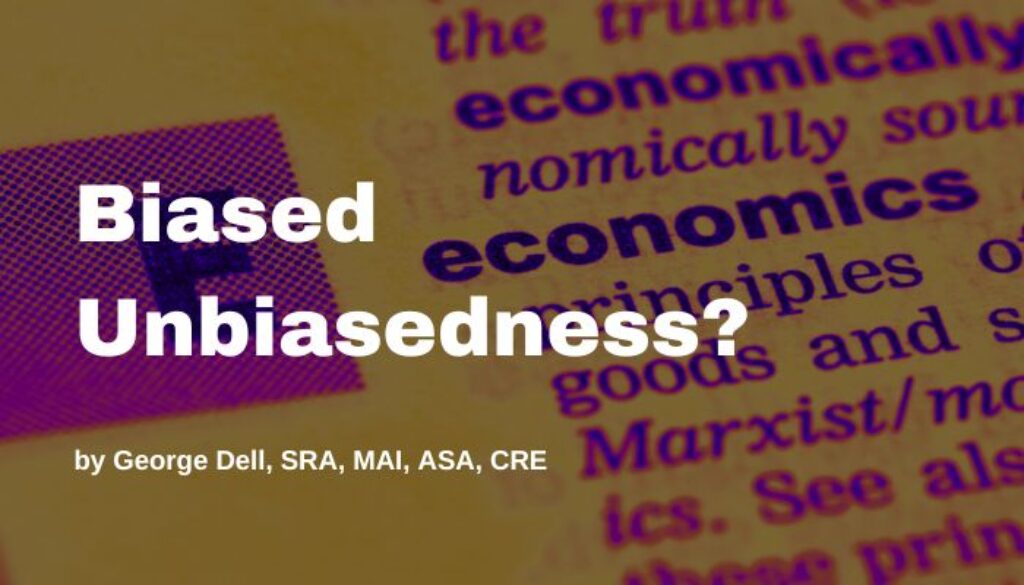Biased thinking, biased analysis — a part of the appraisal process?
The Appraisal Institute is starting to address some bias-related critical issues — head on.
Cindy Chance, the CEO of the AI, in her recent posts noted the role of human bias as a natural phenomena of the survival of the species. She cited the well-known works of Daniel Kahneman and Amos Tversky on “non-rational” economic behavior.
How is this relevant to appraisal theory?
Valuation is based mostly on micro-economics, the interactions of business and individuals. The most relevant part of this economic theory is that the players optimize their decisions of money or usefulness. This is a fundamental assumption of micro-economic relationships.
The resulting supply-demand interactions then become the basis of property valuation. They assume that buyers, sellers, and agents act in a rational manner to maximize their monetary or ‘utility’ benefit. This assumption is often not true.
Daniel Kahneman was awarded the Nobel prize in recognition of his empirical research, which found a reality — that humans do not always maximize their utility. Darn. Irrational decisions. Aw shucks.
How does this reflect on the two traditional goals of appraisal? 1) get the right comps; 2) make ‘reasonable’ adjustments.
If we consider how the entire body of knowledge of appraisal practice is contained in these two notions, we can begin to understand why our “research” can only be judged by believability, not by accuracy.
We can begin to understand why adjustments do not work! There is uncertainty, variation, and illogic, and no real mathematical solution. Darn.
What does work?
In the Valuemetrics curriculum, we deal with this human condition head on. The learning (in the SGDS1 course) is formed around four topics: Data, Theory, Mechanics, and Critical thinking. These four form the basis of the science of data analysis.
- Data: Data analysis is the work – facts, logic, and human interface.
- Theory: Asset economics recognizes non-rationality and human bias.
- Mechanics: We utilize the current state-of-the-art computation capabilities.
- Critical thinking: Evidence Based Valuation (EBV)© recognizes the expert’s role.
We explicitly recognize that some “adjustments” can be mathematically calculated. Other adjustments can only be estimated with a level of uncertainty. And other adjustments are not ‘supportable’ and non-sensical – because of Kahneman non-rationality, sparse data, and unique property elements.
The critical thinking skills comprise logic, reasoning types, and the brain-machine partnership, built upon ethical principles, including rational skepticism and understanding of human and analytic bias. It requires an understanding of the scientific method, and the importance of the expert in applying the right model for the computer algorithm. These skills are a necessary part of professional judgment.
Sadly, critical thinking is not currently a part of “required” appraiser education. But now we can replace the existing culture of “admonish, blame, and punish” — with clarity and rationality!
The good news is adjustments are much less important when using data science data analysis practices. The work is reproducible, understandable, and can provide a risk/reliability score system which can enhance lender/user decision risk systems. And it is more fun!

April 29, 2024 @ 9:20 am
Economics and finance moved away from the rational-man hypothesis decades ago, but appraisal is stuck in it. I think the root problem is a failure to define “market value.” Is it a prediction of sale price in reality? A prediction in an alternate reality of perfect information and rational actors who are normally motivated and understand their motivations? A normative enterprise, e.g., what price is “fair,” what a piece of real estate “should” sell for?
I would ask all teachers and reviewers two things, among others. First, why do agents believe that staging a house results in a higher price or quicker sale? Is it true? Doesn’t it contradict the assumptions of appraisal theory? The buyer doesn’t buy the rights to the furniture or the cinnamon smell.
Second, do we make adjustment grids for other major purchases? What’s the adjustment factor for horsepower in a car or truck, or cubic feet of trunk room? Are those adjustments linear, or subject to marginal utility? The answer is, people just don’t make economic decisions the way appraisers do. Sufficient data can reveal patterns that people aren’t aware of, and that’s social science. But appraisal is stuck in a pattern of 3-4 comps, put ’em on a grid, make up some adjustments (say you got them from agents, who made them up themselves), and ship it.